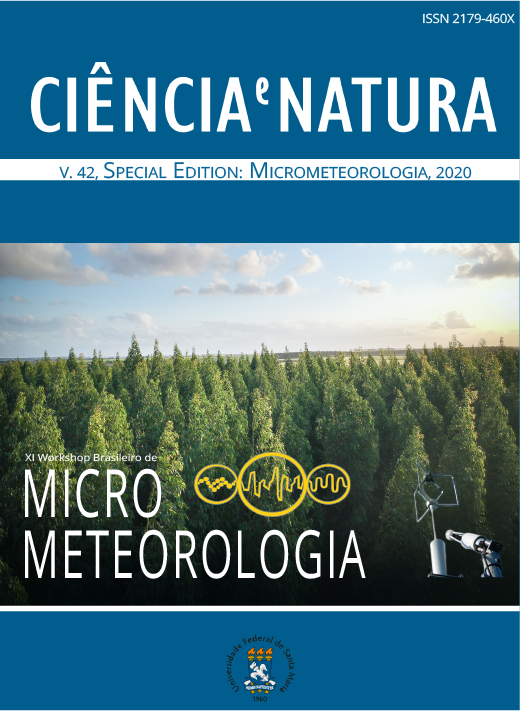Nighttime analysis of the mechanisms that control CO2 and H2O gradients in a coastal region
DOI:
https://doi.org/10.5902/2179460X46923Keywords:
CO2 gradient, H2O gradient, ThermeletricAbstract
Understanding the water and carbon exchange in the soil-atmosphere system and the mechanisms that control these exchanges are fundamental to have a real and adequate representation of the physical processes involved. Under stable night conditions, carbon transfer processes such as respiration and water transfer processes such as dew deposition are more difficult to study by the eddy covariance method. Thus, the aim of this study is to investigate the mechanisms that control the exchange of water and carbon dioxide near a thermal power plant and the ocean, through the gradients of concentration of these quantities at different levels in the atmosphere. Data from the experimental site located in Linhares - ES - Brazil (19° 31'53 "S, 39° 48'03" W), 4 km from the coast and about 250 m from Linhares Geração SA thermeletric, were used. The concentrations of CO2 and H2O are measured by the AP200-Campbell system, which consists of vertically arranged chambers that pull gas flow at the following levels 1, 2, 5, 9, 15 and 20 m. In this study, a total of 67 nights (from 9 pm to 5 am), from 2017, were selected. The wind direction was from the north so that there was no interference from the thermal plant's feathers in the data analysis.
Downloads
References
ACEVEDO, O. C.; DEGRAZIA, G. A.; PUHALES, F. S.; MARTINS, L. G.; OLIVEIRA, P. E.; TEICHRIEB, C.; SILVA, S. M.; MARONEZE, R.; BODMANN, B.; MORTARINI, L. et al. Monitoring the micrometeorology of a coastal site next to a thermal power plant from the surface to 140 m. Bulletin of the American Meteorological Society, v. 99, n. 4, p. 725–738, 2018.
ACEVEDO, O. C.; MARONEZE, R.; COSTA, F. D.; PUHALES, F. S.; DEGRAZIA, G. A.; MARTINS, L. G.; OLIVEIRA, P. E. S.; MORTARINI, L. The nocturnal boundary layer transition from weakly to very stable. part 1: Observations. Quarterly Journal of the Royal Meteorological Society, Wiley Online Library, 2019.
AUBINET, M.; VESALA, T.; PAPALE, D. Eddy covariance: a practical guide to measurement and data analysis. [S.l.]: Springer Science & Business Media, 2012.
Google Earth. Google Earth. 2019. Acesso em 20 ago. 2019. Disponível em: earth.google.com/web/.
GU, L.; FALGE, E. M.; BODEN, T.; BALDOCCHI, D. D.; BLACK, T.; SALESKA, S. R.; SUNI, T.; VERMA, S. B.; VESALA, T.; WOFSY, S. C. et al. Objective threshold determination for nighttime eddy flux filtering. Agricultural and Forest Meteorology, Elsevier, v. 128, n. 3-4, p. 179–197, 2005.
MÖLDER, M.; LINDROTH, A.; HALLDIN, S. Water vapor, co2, and temperature profiles in and above a forest—accuracy assessment of an unattended measurement system. Journal of atmospheric and oceanic technology, v. 17, n. 4, p. 417–425, 2000.
MONTAGNANI, L.; GRÜNWALD, T.; KOWALSKI, A.; MAMMARELLA, I.; MERBOLD, L.; METZGER, S.; SEDLÁK, P.; SIEBICKE, L. Estimating the storage term in eddy covariance measurements: the icos methodology. International agrophysics, Sciendo, v. 32, n. 4, p. 551–567, 2018.
NICOLINI, G.; AUBINET, M.; FEIGENWINTER, C.; HEINESCH, B.; LINDROTH, A.; MAMADOU, O.; MODEROW, U.; MÖLDER, M.; MONTAGNANI, L.; REBMANN, C. et al. Impact of co2 storage flux sampling uncertainty on net ecosystem exchange measured by eddy covariance. Agricultural and forest meteorology, Elsevier, v. 248, p. 228–239, 2018.
SCHMUTZ, M.; VOGT, R. Flux similarity and turbulent transport of momentum, heat and carbon dioxide in the urban boundary layer. Boundary-Layer Meteorology, Springer, v. 172, n. 1, p. 45–65, 2019.
Downloads
Published
How to Cite
Issue
Section
License
To access the DECLARATION AND TRANSFER OF COPYRIGHT AUTHOR’S DECLARATION AND COPYRIGHT LICENSE click here.
Ethical Guidelines for Journal Publication
The Ciência e Natura journal is committed to ensuring ethics in publication and quality of articles.
Conformance to standards of ethical behavior is therefore expected of all parties involved: Authors, Editors, Reviewers, and the Publisher.
In particular,
Authors: Authors should present an objective discussion of the significance of research work as well as sufficient detail and references to permit others to replicate the experiments. Fraudulent or knowingly inaccurate statements constitute unethical behavior and are unacceptable. Review Articles should also be objective, comprehensive, and accurate accounts of the state of the art. The Authors should ensure that their work is entirely original works, and if the work and/or words of others have been used, this has been appropriately acknowledged. Plagiarism in all its forms constitutes unethical publishing behavior and is unacceptable. Submitting the same manuscript to more than one journal concurrently constitutes unethical publishing behavior and is unacceptable. Authors should not submit articles describing essentially the same research to more than one journal. The corresponding Author should ensure that there is a full consensus of all Co-authors in approving the final version of the paper and its submission for publication.
Editors: Editors should evaluate manuscripts exclusively on the basis of their academic merit. An Editor must not use unpublished information in the editor's own research without the express written consent of the Author. Editors should take reasonable responsive measures when ethical complaints have been presented concerning a submitted manuscript or published paper.
Reviewers: Any manuscripts received for review must be treated as confidential documents. Privileged information or ideas obtained through peer review must be kept confidential and not used for personal advantage. Reviewers should be conducted objectively, and observations should be formulated clearly with supporting arguments, so that Authors can use them for improving the paper. Any selected Reviewer who feels unqualified to review the research reported in a manuscript or knows that its prompt review will be impossible should notify the Editor and excuse himself from the review process. Reviewers should not consider manuscripts in which they have conflicts of interest resulting from competitive, collaborative, or other relationships or connections with any of the authors, companies, or institutions connected to the papers.







